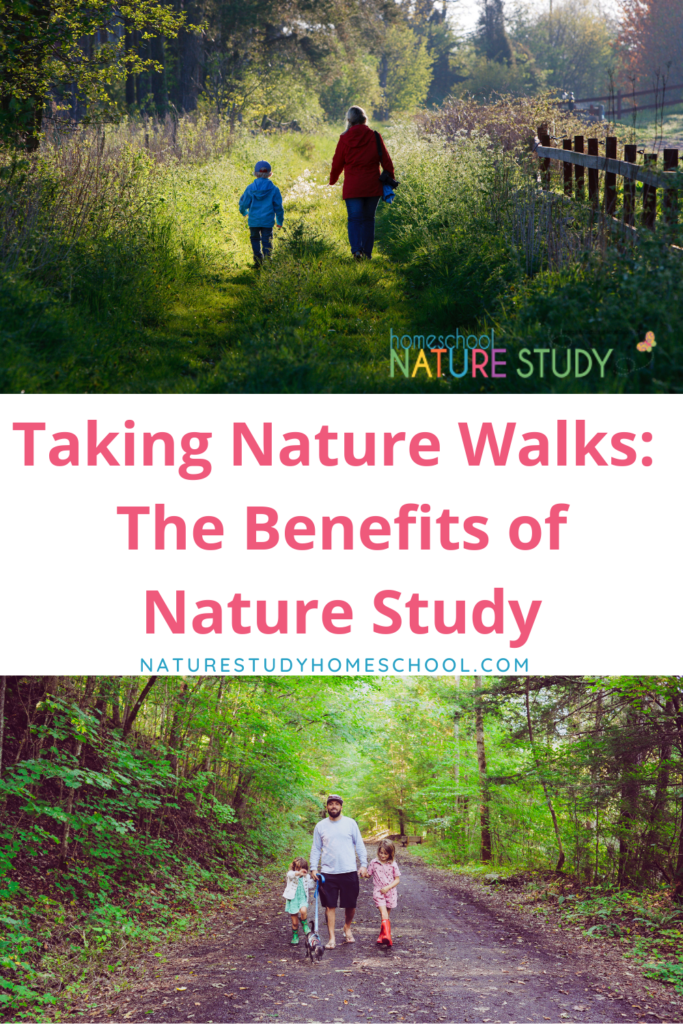The idea of taking a nature walk is nothing new. However, the need for nature walks has never been more evident in our increasingly indoor, sedentary lives. Childhood used to be times of exploring outdoors for hours at a time, but in today’s world few children have the circumstances or incentive to get outside on their own. This is where involved parents can be of such value.
“Time in nature is not leisure time; it’s an essential investment in our children’s health (and also, by the way, in our own).”
― Richard Louv, Last Child in the Woods: Saving Our Children from Nature-Deficit Disorder
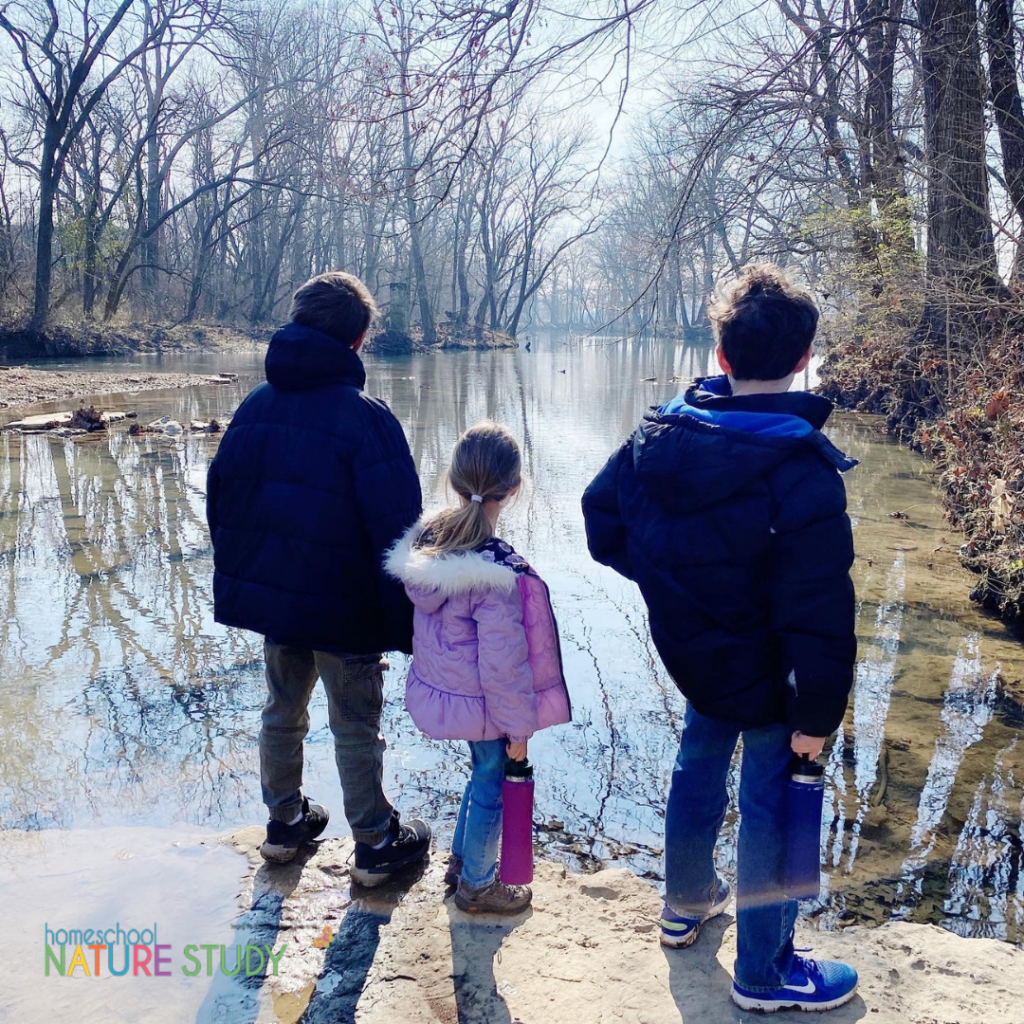
Building the Nature Walk Habit In your Homeschool
Taking a nature walk can bring refreshment to your whole family. Maybe you are having a tough day and the children are a little restless or perhaps the weather is just too nice to stay inside all day…these are perfect opportunities to drop everything else and take a walk in your own neighborhood or a park close by.
I’ve observed that families that take nature walks on a consistent basis, as part of their weekly routine, benefit greatly from the efforts they spend in making them happen. They feel more relaxed in nature, they see their children get excited about things they discover, and they feel a closer bond as a family because of shared nature experiences.
Whether you use the Outdoor Hour Challenges as part of your nature studies or not, the fundamental idea of taking a short walk outside with your child is the basis of building a happier childhood.
“Nature is often overlooked as a healing balm for the emotional hardships in a child’s life.”
― Richard Louv, Last Child in the Woods: Saving Our Children from Nature-Deficit Disorder
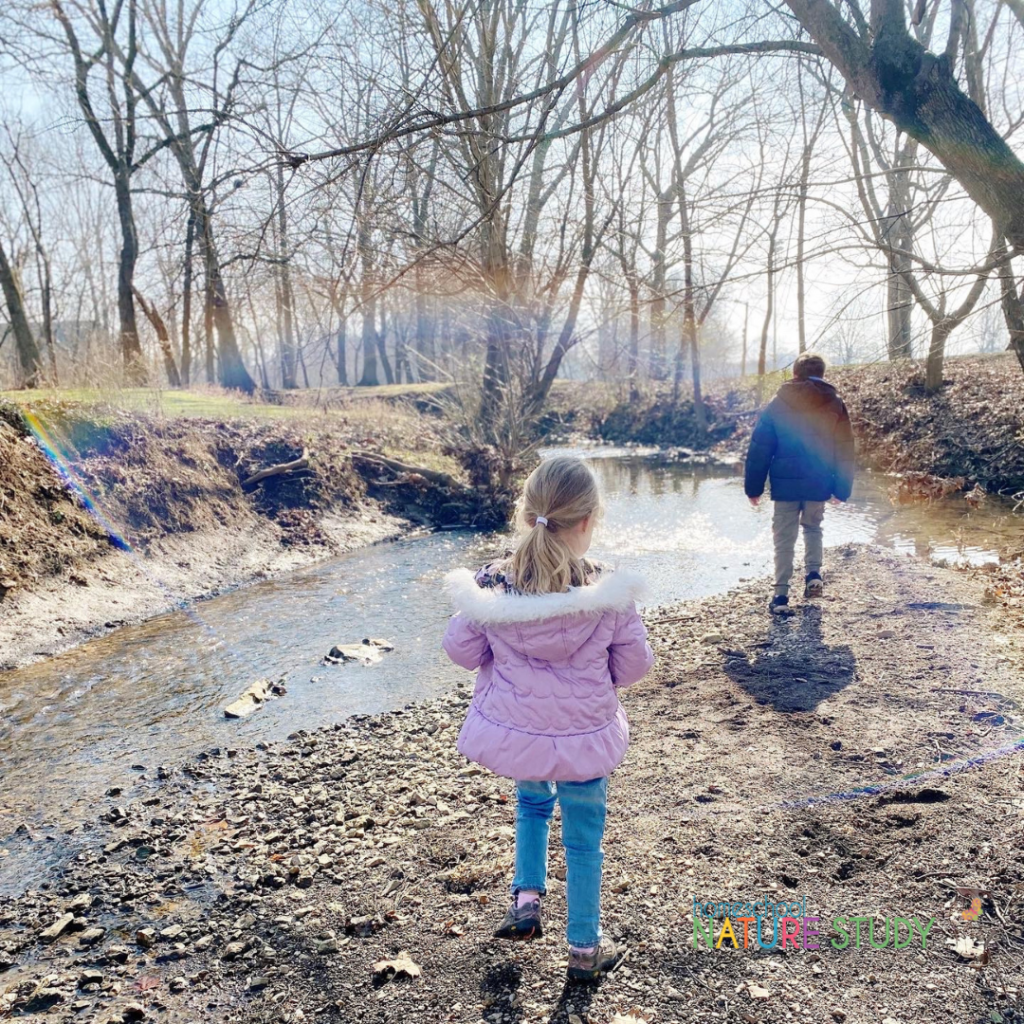
Getting the Habit of Walks Started with The Outdoor Hour Challenge
Talking nature walks can be as simple as putting on your shoes and jacket and heading out the door, letting nature inspire what you do and what you study. Or, you can have a few ideas in mind before you head out the door.
Sometimes it’s nice to head out the door and see what comes your way, no assignments. Start with nothing more than pointing out the beauty in the flowers, trees, animals, and birds that you encounter during your everyday life. Speak to the heart at first by just enjoying the amazing living things in front of you and then eventually you will be able to focus on naming your subjects and knowing a few facts.
Parents do not need to be worried that they don’t know everything about their nature study subjects. You can become learners right alongside your children. Remember that there are many things about nature that nobody knows the answers to so when our children ask us questions that are deep and thought-provoking, acknowledge the question and look for the answer together. We are all students of God’s creation, and we will never know everything there is to know.
Consider nature study an adventure, a lifelong achievement. Keep your eyes wide open for opportunities to discover new things that come into your everyday life.
It doesn’t have to be an elaborate affair or take very much time for you to see a difference in your attitude and that of your children.
“It is a mistake to think that a half day is necessary for a field lesson (nature walk), since a very efficient field trip may be made during the ten or fifteen minutes at recess, if it is well planned.”
Handbook of Nature Study
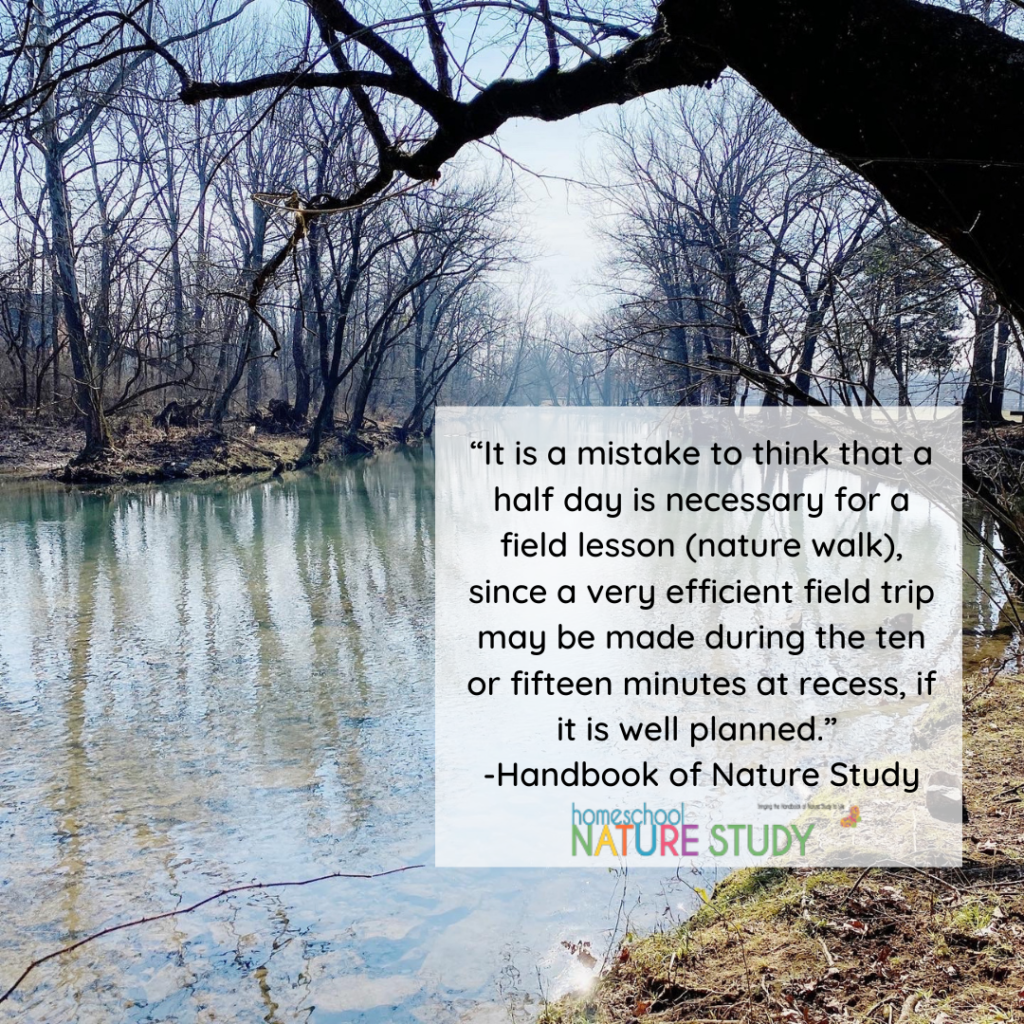
Creative Nature Walks: Pick a Focus For Your Study
Pick a theme for your walk such as insects, birds, trees, flowers, etc. Then have everyone make observations within that theme.
In my experience, having a focus during a walk makes it much more enjoyable for everyone. Each person can use their eyes and senses to look for items within the theme and then share them with the group. One person can be the designated photographer and take photos of things of interest. Or take along your nature journal and make a record of your sightings as you go along.
If you have older children, this is where you could use the Outdoor Hour Challenge and the Handbook of Nature Study to pick a focus for your walk. Pick a topic for the many challenges available and be on the lookout for the subject of interest.
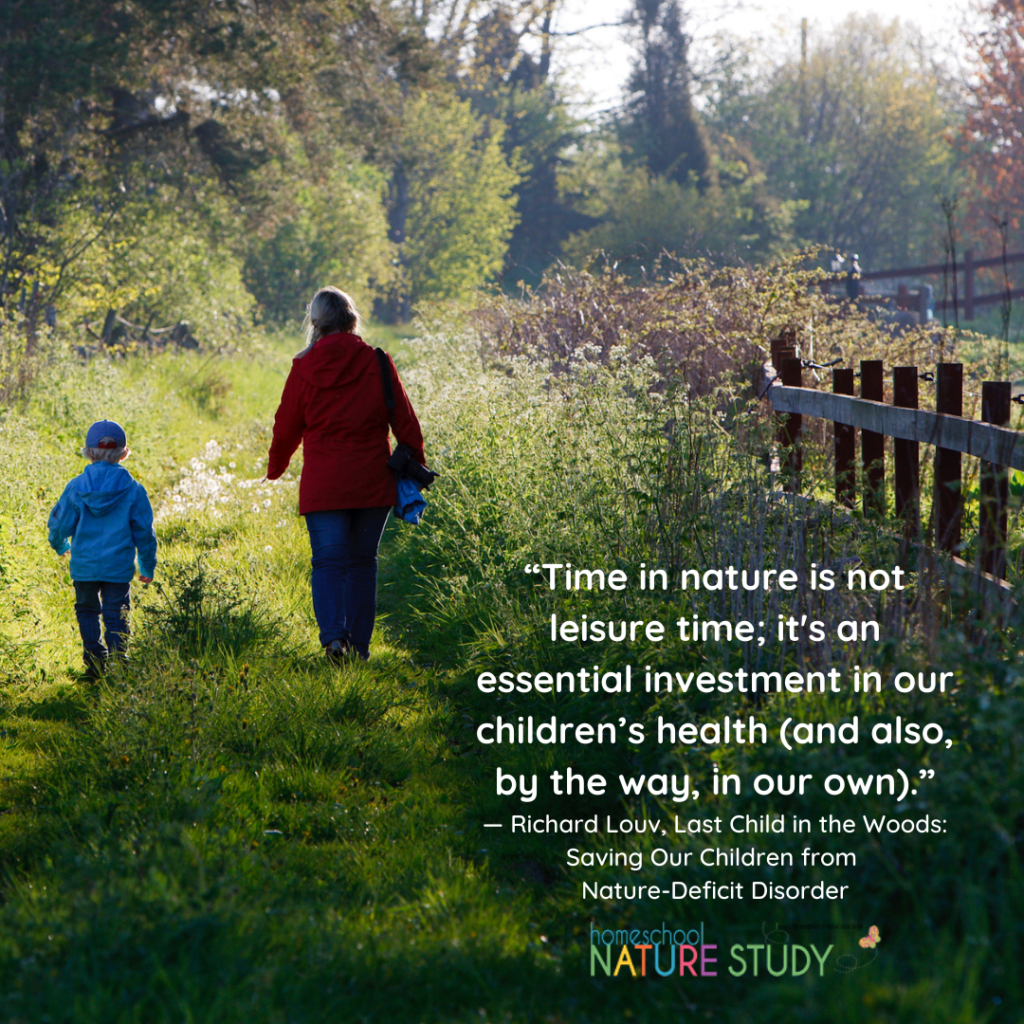
How Long Should Outdoor Time Be and How Frequently?
Short regular walks are much better than the occasional walk. The trick is to find a balance that works in your family. When my boys were homeschooling, we aimed for a once a week walk or hike with a little follow up once we got home. In high school, our walks became less frequent, but we aimed to take a “nature day” once a month where we would take the time to get outside together and explore as part of our more formal nature study program.
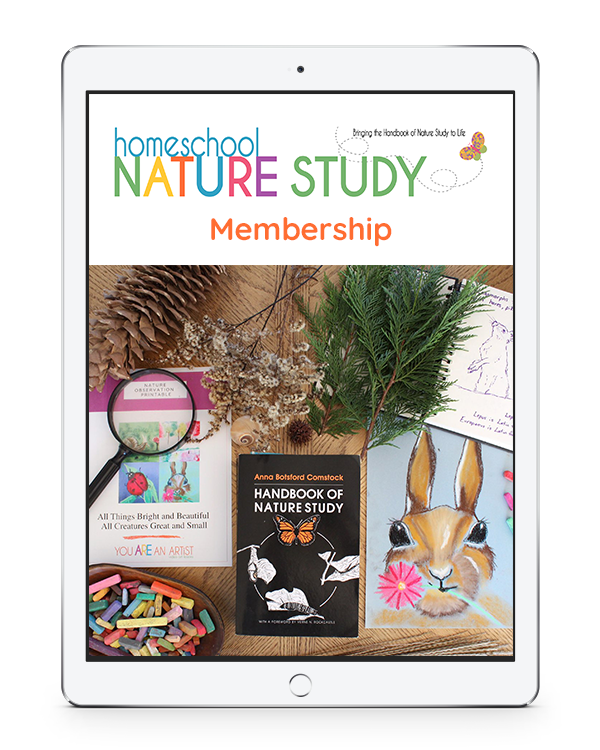
Help Getting Started with the Nature Walk Habit in Homeschool Nature Study Membership
Below you will find links and resources for Homeschool Nature Study members to use as part of your nature walk time and usually a follow up idea for your nature journal. Please pick those ideas that get you excited to give regular nature walks a place in your family’s weekly routines.
Homeschool Nature Study Members:
- Read “The Field Excursion” on page 14 of the Handbook of Nature Study.
- Getting Started Guide – Outdoor Hour Challenge #1
- Autumn course – Fall Color Walk Challenge
- Spring course – Spring Splendor Walk
Printable Journal pages
- My Nature Walk – Senses Notebook Page
- Silent Autumn Nature Walk
- Spring Nature Hunt
- Spring Walk
- 1st Day of Winter Nature Walk printable
- 3 Questions Hike
- My Summer Nature Hike
- 5 Senses Walk at Sunset Notebook Page
- Walk in the Forest Notebook Page
Nature study using the Outdoor Hour Challenge aims to introduce you to your own backyard and neighborhood, seeking out the things that interest your children. I invite you to get to know your child’s special area of interest and to build from there a foundation of knowledge and experience outdoors. Using the Outdoor Hour Challenges, my own family has been enriched with a love of nature, a bond with each other, and lots of wonderful memories of seasons past.
If you’re not a member here on Homeschool Nature Study yet, please consider joining to gain the benefit of having a nature study library at your fingertips. There are numerous resources available for you to help create the habit of nature study within your family.
